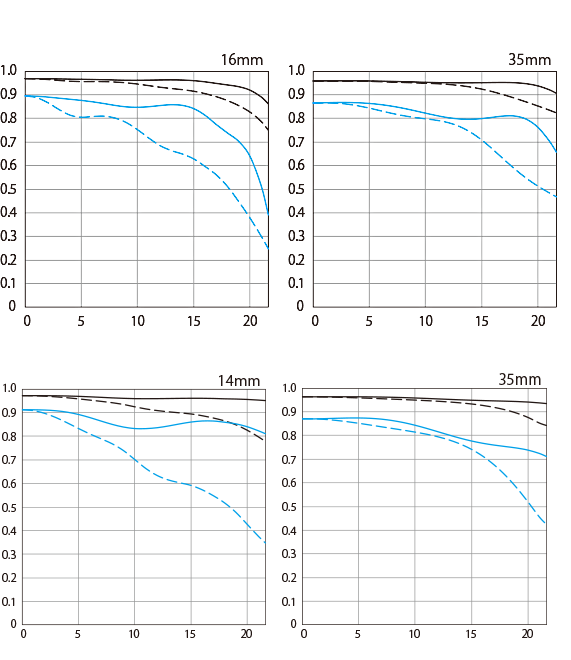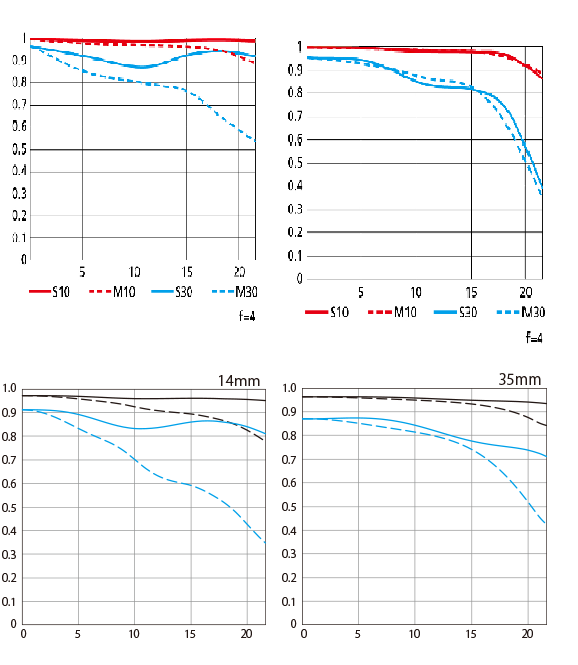Canon RF 14-35mm F4L IS USM MTF and Comparisons
As we usually do, we dug up the MTF graphs for the Canon RF 14-35mm and immediately wanted to see how it compared to the Canon EF 16-35mm F4L IS USM.
Now first we have to consider that the 14-35 is a 2.5x zoom while the 16-35mm is approaching a 2x zoom. Why does this matter? The greater the zoom range the more difficult it is to make the lens good throughout the entire range. That's why the 24-70's are much better than the 24-105 lenses and why 28-70mm is easier to achieve maximum performance as well.
The top MTF is the 16-35mm EF version and the bottom is the 14-35mm. First, no one complains about the Canon EF 16-35mm. I mean no one. The lens is fantastic. The 14-35mm has a bit more astigmatism than the 16-35mm but contrast and sharpness should be very comparable across the entire range. So if you like the 16-35mm F4L you'll also like the 14-35mm F4L.

Next, is an apt comparison because it's Canon's competitor - Nikon. Nikon has also released an F4 ultrawide zoom, the Nikkor S 14-30mm F4. It should be noted that the zoom range is smaller and also this lens does not have IS. While some people will diss the need for IS, think interior where tripods are not necessary. Both Canon and Nikon have cameras that do not have IBIS. However, in Nikon's favor - the lens came out nearly $400 cheaper than the Canon 14-35mm.
The Nikkor is at the top, and the Canon is at the bottom. At the most important wide end, I'd have to give the advantage slightly to the Nikkor. however, you'd be hard pressed to tell the difference. the Nikkor has a bit more sharpness in the center and tails off into the corners slightly less than the Canon lens. It also has less astigmatism, but it's far from perfect.

In other aspects how do all these lenses compare?
| |
Canon RF 14-35mm F4L IS USM |
Canon EF 16-35mm F4L IS USM |
Nikkor 14-30mm F4 S |
| Max Magnification |
0.38× |
0.23x |
0.16x |
| Zoom Range |
2.5x |
2.19x |
2.14x |
| FIlter Size |
77 mm |
77 mm |
82mm |
| Image Stabilization |
5.5 Stops |
4 stops |
N/A |
| Construction |
16 Elements in 12 Groups |
16 Elements in 12 Groups |
14 elements, 12 groups |
| Weight |
544 g |
615g |
485g |
| Aperture Blades |
9, Rounded |
9, Rounded |
7 blades rounded |
| Size |
84 x 99 mm |
82.6 x 112.8 mm |
89 x 85 mm |
| Price |
$1699 |
$1199 MSRP ($1365 in 2021) |
$1296 (on sale for $1096) |
The Canon RF 14-35mm certainly stands out in terms of price, especially when compared to the Nikkor. However, the Canon uses a smaller filter which can and will save you hundreds if not more depending on how often you use filters, and if you already have a 77mm set versus an 82mm set. The Nikkor also doesn't have stabilization which in my mind as long as you sell cameras without IBIS is certainly important. Is it worth the $400 premium that Canon has put on the lens? That's up to you to decide.
I do strongly recommend preordering the Canon RF 14-35mm as soon as possible.
You can do so from our partner, B&H Photovideo
7334